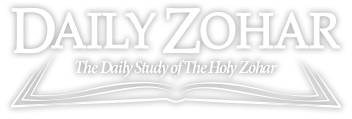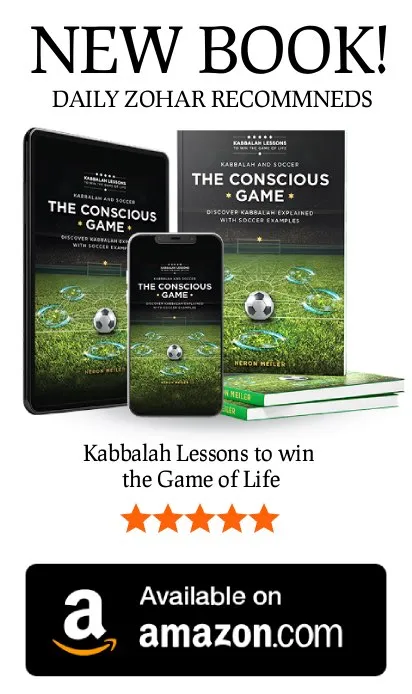Daily Zohar # 4653 – Acharei Mot – Tzadik is the foundation of the world
Daily Zohar 4653

Hebrew translation:
233. אָמַר רַבִּי יִצְחָק לְרַבִּי שִׁמְעוֹן, אִם נוֹחַ לִפְנֵי מוֹרִי, זֶה שֶׁשָּׁנִינוּ שֶׁכָּתוּב (משלי י) וְצַדִּיק יְסוֹד עוֹלָם, יֵשׁ מִי שֶׁאוֹמֵר שֶׁעַל שִׁבְעָה עַמּוּדִים עוֹמֵד הָעוֹלָם, וְיֵשׁ מִי שֶׁאוֹמֵר עַל עַמּוּד אֶחָד עוֹמֵד הָעוֹלָם, אֵיךְ הַדְּבָרִים מִתְיַשְּׁבִים? אָמַר לוֹ, הַכֹּל הוּא דָּבָר אֶחָד, שֶׁהֲרֵי שִׁבְעָה הֵם, וּבָהֶם יֵשׁ עַמּוּד אֶחָד שֶׁנִּקְרָא צַדִּיק, וְעוֹמְדִים עָלָיו, וְהָעוֹלָם מִתְקַיֵּם עַל זֶה. וּכְשֶׁהָעוֹלָם מִתְקַיֵּם עָלָיו, כְּאִלּוּ שֶׁהִתְקַיֵּם עַל כָּל הַשִּׁבְעָה, וְעַל כֵּן כָּתוּב וְצַדִּיק יְסוֹד עוֹלָם, וַהֲרֵי בֵּאַרְנוּ אֶת הַדְּבָרִים בְּכַמָּה מְקוֹמוֹת.
.
Zohar Acharei Mot
Continued from previous DZ
#232
Concerning ‘Poor and riding on a donkey’ (Zechariah 9:9), it is written: because he was poor from the beginning and was riding on a donkey, as we have explained. The donkey represents the lower levels of Keter of the other nations, the idol worshipers whose firstborn was struck in Egypt by the Holy One. Blessed be He. The other nations are referred to as ‘donkeys,’ as it is written, ‘And all the firstborn of the animals’ (Exodus 13:15). We have already explained this. It is as if the verse is saying, ‘He is Tzadik and having salvation,’ for he is indeed saved more than anyone. This is because until now, the Tzadik, who is the Yessod, was dwelling without the ‘צדק’ ‘Tzedek,’ which is Malchut. Now that Tzadik and Tzedek are united, Tzadik is truly saved because he no longer dwells on the Other Side (Sitra Achra).
We have learned that it is written: ‘The Tzadik perish, and no man pays attention to it’ (Isaiah 57:1). This verse is tricky: It should have said ‘perished’ in the past tense. What does it mean by ‘perish’? Rather, it means truly perished. And what has perished? The Queen (Malchut) has perished and became attached to another place, which is called ‘שִׁפְחָה’ ‘maidservant.'”
#233
Rabbi Yitzhak said to Rabbi Shimon: “If it pleases my master, I wish to understand what we have learned about the verse ‘וְצַדִּיק יְסוֹד עוֹלָם’ ‘The Tzadik is the foundation of the world’ (Proverbs 10:25). Some say that the world stands on seven pillars, while others say that it stands on one pillar, which is Yessod, as it is written, ‘The righteous is the foundation of the world.’ How can these views be reconciled without contradicting each other?”
Rabbi Shimon replied: “It is all one concept. There are seven pillars, which are the seven lower sefirot (Chessed, Gevurah, Tiferet, Netzach, Hod, Yessod, Malchut), and among them, there is one pillar called ‘Tzadik,’ which is Yessod. All seven depend on this one, and the world is sustained. When Yessod sustains the world, it is as though it is sustained by all seven because Yessod includes all seven sefirot within itself (Chessed, Gevurah, Tiferet, Netzach, Hod, Yessod, Malchut). Therefore, it is written, ‘The Tzadik is the foundation (Yessod) of the world.’ And we have already explained this in several places.
Notes:
Rabbi Yitzhak asks Rabbi Shimon to clarify the idea of how the world is sustained. Rabbi Shimon explains that both teachings are true and part of the same structure. The seven pillars refer to the seven lower sefirot, which represent the flow of Light that sustains the world. However, among these seven, Yessod is particularly significant because it connects and includes all the other sefirot, serving as a channel for the Light to flow into the world.
The teaching that the world stands on one pillar, Yessod, means that Yessod plays a central and foundational role in sustaining the entire system. However, since Yessod contains and is connected to all the other sefirot, the world stands on all seven pillars (Sefirot), with Yessod as their culmination. This reconciliation highlights the importance of Yessod as the “foundation of the world” while acknowledging the interconnection of levels of the Tree of Life.
{||}

 Previous: Acharei Mot
Previous: Acharei Mot

